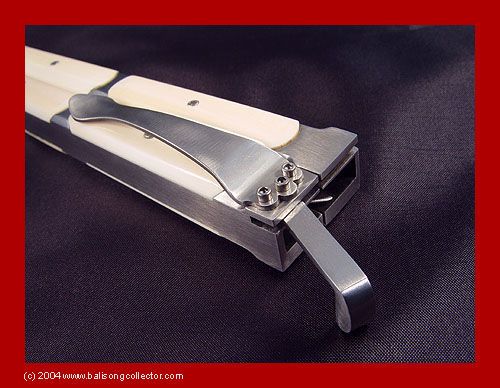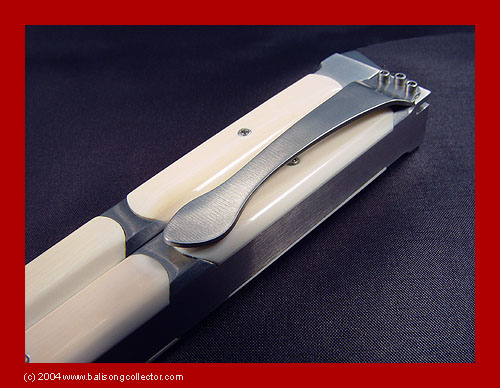

The blade is a great clip-point bowie done in Devon Thomas Damascus steel. Mr. Devon "Hoss" Thomas of Panaca, Nevada is one of the finest makers of Damascus steel in the world today.
You can see the wavy lines of the Damascus pattern. But, if you look carefully, you can see another horizontal line in the steel just a little above the edge.
no high-resolution version available
This is called a "hammon line" and it comes from differentially tempering the blade. The steel "above" this line is softer than the steel below it. The hard steel below the hammon line forms the cutting edge of the knife. Making this steel especially hard allows the knife to take and retain an especially-sharp edge. The softer steel above the hammon line is the majority of the structure of the blade. Making this steel a bit softer allows the blade to be more flexible. If the whole blade were made very hard, then the blade would be very brittle and might shatter in use.
The wavy Damascus
lines prove that this is NOT two types of steel somehow fused
together. It is one piece of steel which has been hardened differently
in different regions. Professor Roland Phlip of the Institute for Advanced
Balisong Studies recently
gave a lecture explaining a bit about metal hardening that touched
on differential hardening. To read his lecture, click on this
![]() icon.
icon.
Differential hardening is a difficult process. Most knife makers don't offer it. Differential hardening gives a blade the best of two worlds. Somehow that seems appropriate for this balisong with its split-personality.
The blade is perfectly ground. The grind lines are perfectly symmetric. Here is a picture that I've actually had one knife maker ask me not to show of his knife. Notice how perfectly symmetric this Pabu blade is.

This balisong features Pabu's unique L-latch which allows the blade to run the full length of the handles.

Notice how the handles come together perfectly when the knife is closed. In the picture above, the knife is unlatched and yet you can see that there's almost no space between the handles. Close the latch and the tiny gap you see in the picture above will disappear leaving the appearance that the knife is one solid piece of metal with ivory inserts. Yet despite this, the blade does not rattle in the handles when the knife is closed nor does the edge hit the inside of the channel. Much the same thing is true when the knife is open. The two handles come together exactly giving both the look and the feel of a fixed-blade knife with a solid handle. To achieve this result, everything about the knife must be dimensionally-perfect.
There's also a removable pocket clip which is very nicely executed.

Click on the finger icon to read more about this interesting Pabu balisong .